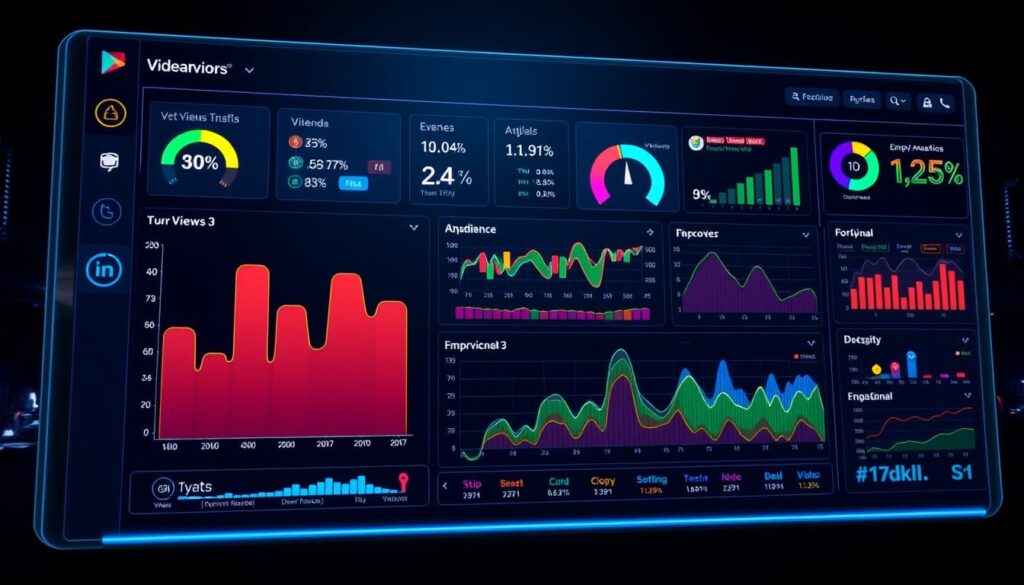Did you know that video content is projected to account for over 82% of all consumer internet traffic by 2022? This statistic underscores the burgeoning significance of video in our digital realm. For content creators and marketers, the ability to optimize video content is paramount. It is essential for enhancing visibility and engaging audiences effectively. By concentrating on video SEO and distribution strategies, one can notably improve their video marketing strategy.
This comprehensive guide will elucidate the critical components of optimizing your video content, ensuring your brand distinguishes itself in a burgeoning marketplace. Grasping the nuances of compelling metadata to captivating engagement metrics will equip you to amplify your online reach and visibility. For a deeper exploration of the advantages of proficient video content optimization, delve into our detailed insights here.
Key Takeaways
- Video content will dominate internet traffic in the coming years.
- Effective video content optimization can boost viewer engagement.
- A well-structured video SEO strategy is essential for visibility.
- Metadata plays a vital role in how videos are discovered online.
- Engagement metrics provide insights into viewer preferences.
- Leveraging social media can enhance video dissemination.
Understanding Video Content Optimization
Optimizing video content is paramount for those aiming to leave a lasting impression in the digital realm. It entails the meticulous refinement of videos to captivate both human audiences and search engines. This endeavor encompasses various elements, including titles, descriptions, and tags, each playing a pivotal role in a well-rounded video content strategy.
What is Video Content Optimization?
At its core, video content optimization revolves around the enhancement of a video’s components to elevate its visibility and efficacy. This encompasses the selection of captivating thumbnails, the creation of engaging titles, and the composition of detailed descriptions. By addressing these elements, creators can position their videos optimally for discovery, thereby optimizing video for search engines.
Why is It Important?
Optimized videos significantly boost visibility on platforms like YouTube, thereby driving increased traffic to content. This heightened visibility often correlates with elevated viewer engagement, fostering organic sharing and bolstering brand loyalty. When content resonates with viewer interests, the likelihood of subscriptions and conversions surges. For a deeper exploration of this topic, refer to this link on video content optimization.
Key Elements of Optimizing Video Content
The creation of compelling video content necessitates a meticulous focus on its fundamental components. Titles, descriptions, tags, and thumbnails are indispensable in the optimization process, significantly enhancing both discoverability and viewer engagement. A thorough comprehension of these elements is crucial for optimizing video metadata effectively.
Video Titles
Video titles act as the initial gateway for potential viewers. They must be succinct yet laden with pertinent keywords to capture search interest. An optimally crafted title can substantially elevate visibility in search results, while accurately conveying the video’s central theme. When formulating video titles, it is imperative to incorporate terms that resonate with your target audience’s search queries.
Descriptions and Tags
Descriptions offer a detailed overview of the video’s content. This is an opportunity to delve into the subject matter and include tags that encapsulate the video’s essence. Tags are instrumental in enhancing video discoverability, facilitating viewers’ ability to locate your content. Implementing effective video metadata optimization strategies can significantly boost engagement rates.
Thumbnails
Thumbnails are the visual embodiment of your video, presenting the initial impression to viewers. They must be captivating and pertinent to the video’s subject matter. Misleading thumbnails can lead to viewer disillusionment and decreased engagement metrics. It is essential to create thumbnails that not only draw attention but also accurately represent the content, fostering viewer trust and sustained interest.
The Role of Metadata in Video Optimization
Metadata is pivotal in video optimization, offering critical information that delineates the essence of your video. Mastery in video metadata optimization can profoundly augment video SEO endeavors. Adequate metadata facilitates search engines’ comprehension of your video’s content, thereby enhancing its discoverability by potential viewers.
What is Metadata?
Metadata encapsulates data that elucidates other data. In the context of videos, it encompasses attributes such as titles, descriptions, tags, and closed captions. Each element contributes to contextual clarity, enabling both search engines and viewers to grasp the video’s subject matter and its relevance. The efficacy of metadata is paramount for enhancing searchability and ensuring that your videos are accessed by the intended audience.
Best Practices for Metadata
Adopting optimal practices in video metadata optimization can significantly elevate visibility on platforms such as YouTube and Vimeo. Consider the following recommendations:
- Employ titles that are succinct and accurately reflect the video’s content.
- Compose detailed descriptions that incorporate pertinent keywords for video SEO.
- Tag your video with relevant keywords to augment discoverability.
- Utilize closed captions to enhance accessibility and facilitate search engine indexing of your video.
Eschew null or inadequately composed metadata, as such shortcomings often lead to diminished view counts due to reduced visibility in search results. Leveraging tools like Google Trends can aid in identifying optimal keywords for your metadata strategy. For additional insights on related concepts, refer to the terms of use.
Leveraging SEO for Video Content
The essence of effective video SEO resides in the meticulous process of keyword research. Grasping the search terms employed by prospective viewers is paramount for the formulation of a triumphant video content strategy. Instruments such as Google Keyword Planner and SEMrush prove indispensable in uncovering pertinent keywords, thereby augmenting your video’s discoverability.
Keyword Research
Keyword research serves as the cornerstone of your video SEO endeavors. By pinpointing prevalent search terms, you can align your video content with viewer requirements. Prioritize keywords that are not only pertinent but also within the realm of attainable competition. This preliminary phase necessitates:
- Employing dependable tools for precise data
- Examining competitor keywords
- Identifying long-tail keywords that specifically attract your target audience
Using Keywords Effectively
Post-acquisition of relevant keywords, the subsequent phase entails their strategic deployment. Optimal practices for keyword integration encompass:
- Integrating keywords organically into your video script
- Embedding keywords within the video’s metadata, encompassing titles, descriptions, and tags
- Naming your video files suitably prior to upload
Adopting these methodologies enables search engines to efficiently correlate your video with pertinent queries. Such a strategy significantly amplifies the visibility of your content.
The Impact of Engagement Metrics
For those aiming to elevate their video content, grasping engagement metrics is paramount. These metrics act as beacons, illuminating the extent to which audiences engage with your videos. They offer crucial insights into refining your content’s performance. To achieve maximum video visibility, it is imperative to scrutinize these metrics, particularly Click-Through Rate (CTR) and Average View Duration.
Click-Through Rate (CTR)
CTR quantifies the frequency with which viewers click on your video upon encountering its title and thumbnail. A diminished CTR may indicate a necessity for enhancing your title or thumbnail to attract a broader audience. The synergy between an alluring thumbnail and an engaging title can substantially elevate CTR, thereby amplifying video visibility. By dissecting this metric, creators can tailor their content strategies and make necessary adjustments.
Average View Duration
Average View Duration gauges the duration for which viewers remain captivated by your video. Elevated view durations signify not only successful viewer retention but also a positive impact on search rankings, thereby expanding your content’s reach. Crafting content that captivates viewers until the conclusion is crucial. By concentrating on engagement metrics such as AVD, creators can hone their approach, ensuring their videos ascend in search rankings.
To delve further into video optimization strategies or for assistance, feel free to contact us.
Social Media Platforms and Video Optimization

Each social media platform presents unique avenues for refining your video marketing strategy. Tailoring your content to align with the specific attributes and inclinations of each platform is paramount for securing audience engagement. By adopting platform-specific strategies, you can substantially elevate engagement metrics and video view counts.
Platform-Specific Strategies
Diverse platforms, such as Facebook, Instagram, TikTok, and YouTube, necessitate distinct video marketing methodologies. For example:
- Instagram: Emphasize short, visually captivating clips that convey a narrative swiftly. Leverage features like Stories and Reels to enhance visibility.
- YouTube: This platform is conducive to longer, more detailed content, making it an excellent venue for tutorials and vlogs that captivate viewers over prolonged durations.
- TikTok: Videos that are creative, trend-oriented, and often incorporate popular music and challenges, excel in this environment, captivating audiences effectively.
Best Times to Post
The timing of your video posts is critical for maximizing viewer interaction. Gaining insight into when your audience is most active on each platform can significantly enhance reach and performance. Utilizing social media analytics tools can offer valuable data on optimal posting times, thereby increasing video views and engagement rates. For a more in-depth exploration of optimizing content across various platforms, refer to this article on video content strategies for different social media.
Creating Compelling Video Content
The art of crafting video content that captivates lies in the mastery of storytelling techniques, which must resonate profoundly with the audience. A narrative structure, characterized by a distinct beginning, middle, and end, not only secures attention but also stirs emotions. The engagement of viewers through relatable characters and scenarios significantly amplifies their connection to the content.
Storytelling Techniques
Effective storytelling within your videos is pivotal for successful engagement. It is crucial to identify key elements such as conflict and resolution to craft a narrative arc that sustains interest. Personal anecdotes or relevant case studies serve to illustrate points succinctly. These strategies render the content not only memorable but also shareable, thereby expanding its reach and influence.
High-Quality Production
High-quality production is imperative for attracting and retaining viewers. Subpar video or audio quality can swiftly lead to disengagement. It is vital to prioritize various video production techniques, including the investment in professional lighting, sound, and editing. These elements significantly contribute to a refined final product. By ensuring a clean and professional aesthetic, you cultivate a positive viewer experience, encouraging repeat visits for further content. For additional video content creation tips, always aim for the highest available resources, techniques, and tools.
Analyzing Video Performance

Grasping the nuances of video performance is paramount for the enhancement of content strategies. Through the utilization of advanced tools, content creators are empowered to make data-driven decisions, influenced by viewer engagement and behavior patterns. Tools such as YouTube Analytics and Google Analytics offer a detailed examination of metrics that elucidate the efficacy of video content.
Tools for Video Analytics
The deployment of efficacious tools is instrumental in refining one’s approach to video analytics. Below are some notable options:
- YouTube Analytics: Provides an exhaustive dataset on viewer demographics, watch time, and traffic origins.
- Google Analytics: Enables the tracking of user interactions on your website, encompassing video engagements.
- Vimeo Analytics: Offers insights into views, engagement, and geographic data for videos hosted on Vimeo.
- Facebook Insights: Analyzes video performance across Facebook, including metrics on likes, shares, and comments.
Interpreting Analytics Data
Post-data collection, the interpretation of analytics data is crucial for strategic enhancements. High drop-off rates may indicate a lack of engagement in certain video segments. By scrutinizing specific metrics, such as:
- Viewer retention: Reveals the duration of audience engagement with the video.
- Click-through rates (CTR): Assesses the efficacy of thumbnails and titles in attracting viewers.
- Engagement metrics: Tracks likes, shares, and comments to gauge viewer interaction levels.
Analyzing these metrics empowers content creators to discern successful strategies and areas requiring refinement, thereby enhancing viewer engagement.
Enhancing User Experience
The creation of a positive user experience is paramount for viewer retention and engagement with content. Recognizing the significance of mobile optimization and accessibility features is fundamental. These elements ensure that your videos are accessible to a broad audience, thereby enhancing viewer satisfaction.
Mobile Optimization
In a realm where smartphones reign supreme, the necessity of optimizing video for mobile viewing is unparalleled. Videos must be effortlessly viewable across a myriad of screen sizes, encompassing:
- Employing responsive design that accommodates diverse devices.
- Ensuring rapid loading times to mitigate viewer frustration.
- Providing high-quality visuals that retain their impact on smaller screens.
Implementing these strategies significantly improves user experience, enabling viewers to interact seamlessly with your content, irrespective of their device.
Accessibility Features
Integrating accessibility features not only expands your audience but also fosters a more inclusive environment. Consider the following accessibility enhancements:
- Adding captions to facilitate comprehension for the hearing impaired.
- Incorporating audio descriptions to assist those with visual impairments.
- Utilizing clear language and visuals to cater to a broader spectrum of viewers.
By prioritizing these elements, you contribute to enhancing user experience and ensure that your audience feels valued. Adapting content in this manner is crucial for optimizing video for search engines, as search engines favor inclusive and user-friendly content.
Staying Updated with Trends
In the rapidly shifting digital terrain, the imperative for brands to remain current with video marketing trends intensifies. The incorporation of live streaming, bespoke video content, and interactive experiences significantly boosts user engagement. These innovations not only captivate but also facilitate the establishment of profound connections between brands and their audience.
Current Trends in Video Marketing
The ascendance of interactive video formats stands out as a pivotal trend in video marketing. These formats enable real-time viewer engagement, a development that aligns with the growing demand for immersive experiences. Brands that adopt these strategies are poised to forge lasting connections, thereby enhancing loyalty and engagement. Furthermore, the utilization of analytics from platforms facilitates the refinement of video marketing strategies, ensuring they remain attuned to audience preferences and emerging trends.
Tools for Video Content Optimization
Efficiently navigating these trends necessitates the deployment of advanced tools such as VidIQ or Tubular Labs. These platforms offer invaluable insights into trending topics, optimal posting times, and effective content strategies. Through continuous assessment and adaptation based on these insights, brands can enhance their video marketing strategies. This ensures the creation of content that resonates with the audience, thereby fostering sustained engagement and growth.
